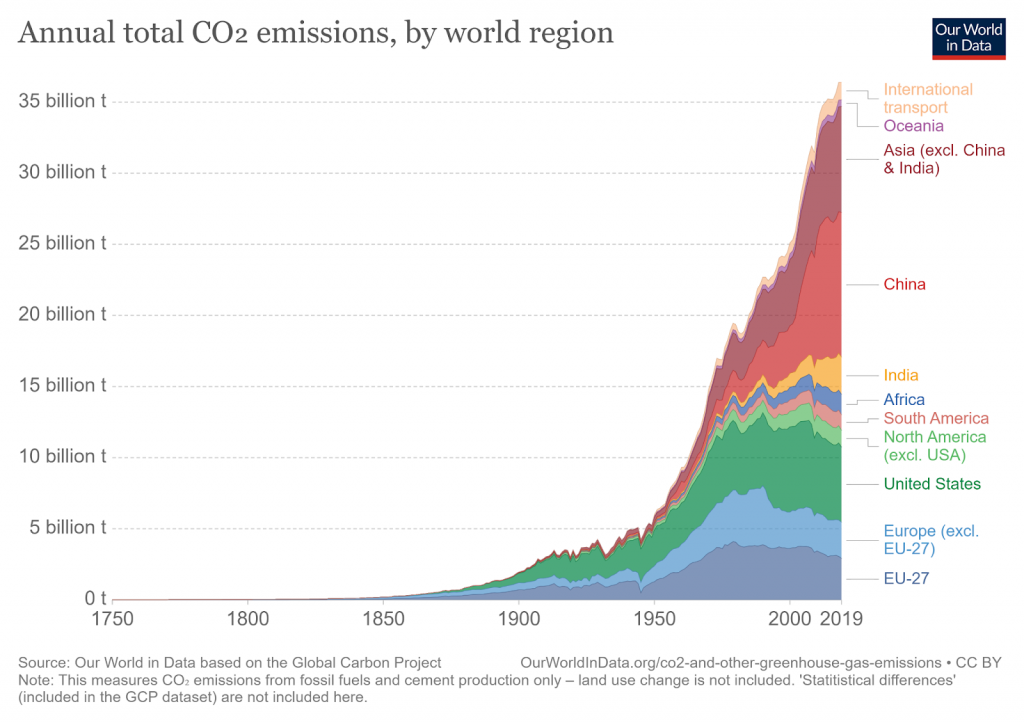How Ethical Is Carbon Offsetting? Here’s the Big Picture
Impactful Ninja is reader-supported. When you buy through links on our site, we may earn an affiliate commission.
Learn more
Learn more
.
Hey fellow impactful ninja ? You may have noticed that Impactful Ninja is all about providing helpful information to make a positive impact on the world and society. And that we love to link back to where we found all the information for each of our posts. Most of these links are informational-based for you to check out their primary sources with one click. But some of these links are so-called "affiliate links" to products that we recommend. First and foremost, because we believe that they add value to you. For example, when we wrote a post about the environmental impact of long showers, we came across an EPA recommendation to use WaterSense showerheads. So we linked to where you can find them. Or, for many of our posts, we also link to our favorite books on that topic so that you can get a much more holistic overview than one single blog post could provide. And when there is an affiliate program for these products, we sign up for it. For example, as Amazon Associates, we earn from qualifying purchases. First, and most importantly, we still only recommend products that we believe add value for you. When you buy something through one of our affiliate links, we may earn a small commission - but at no additional costs to you. And when you buy something through a link that is not an affiliate link, we won’t receive any commission but we’ll still be happy to have helped you. When we find products that we believe add value to you and the seller has an affiliate program, we sign up for it. When you buy something through one of our affiliate links, we may earn a small commission (at no extra costs to you). And at this point in time, all money is reinvested in sharing the most helpful content with you. This includes all operating costs for running this site and the content creation itself. You may have noticed by the way Impactful Ninja is operated that money is not the driving factor behind it. It is a passion project of mine and I love to share helpful information with you to make a positive impact on the world and society. However, it's a project in that I invest a lot of time and also quite some money. Eventually, my dream is to one day turn this passion project into my full-time job and provide even more helpful information. But that's still a long time to go. Stay impactful,Affiliate Disclosure
Why do we add these product links?
What do these affiliate links mean for you?
What do these affiliate links mean for us?
What does this mean for me personally?
![]()
Some refer to carbon offsetting as a panacea for climate change because it is a system that reduces carbon emissions in areas where reductions would otherwise be impossible. So, we had to ask: how ethical is carbon offsetting?
Carbon offsetting can be seen as unethical because it does not work at the core issue of reducing CO2 emissions, it creates a wealth gap between “rich” and “poor” countries, and is often used as greenwashing. Reducing carbon emissions instead of offsetting them would be the most ethical way.
Although carbon offsetting can be used in ways that make them unethical, there are more ethical alternatives. Keep reading to learn about the ethics of carbon offsetting and what these more ethical alternatives are.
How Are Carbon Offsetting and Ethics Defined
Carbon offsets can play a crucial role in reducing our carbon footprint, the amount of carbon dioxide (CO2) emissions associated with an individual or an entity. They are measured in tons of CO2 equivalents and are bought and sold through international brokers, online retailers, and trading platforms.
“Carbon Offset: a way for a company or person to reduce the level of carbon dioxide for which they are responsible by paying money to a company that works to reduce the total amount produced in the world, for example by planting trees”
Oxford Dictionary
When you hear the words “carbon offset”, think about the term “compensation”. Essentially, carbon offsets are reductions in greenhouse gas (GHG) emissions that are used to compensate for emissions occurring elsewhere.
When you purchase a carbon offset, you are paying someone else to offset your emissions. And this is where the ethics, or moral philosophy, surrounding carbon offsets comes into question.
“Ethics: the study of what is morally right and wrong, or a set of beliefs about what is morally right and wrong”
Cambridge Dictionary
Carbon offsets can help reduce carbon emissions from coal, oil, and natural gas. And reducing consumption of these has huge impacts on environmental, economic, and public health. But the indirect method with which offsets operate begs the question: can carbon offsetting be ethical if you offload your emissions onto someone else for them to reduce?
Here’s How Ethical Carbon Offsetting Is
We already have governmental-level policies in place to reduce CO2 emissions, but carbon offsets are able to reduce emissions from activities where sustainable alternatives are not yet widely available. But whether or not this is the most ethical approach to mitigating climate change is highly debatable.
| Ethical Dilemma | Quick Facts |
| Carbon offsets do not work at the core issue of reducing CO2 emissions | Global warming is still occurring at an accelerated rate because offsetting CO2 emissions does not cut CO2 emissions at the source, it only mitigates emissions. |
| There are not enough offsets for all CO2 emissions | We emit far more CO2 than we can offset because of carbon sink (e.g., atmosphere, forests, soil, ocean) limitations. |
| “Poorer” countries are paid to offset carbon while the “rich” countries continue to emit | The richest of the world emit the majority of the world’s carbon. Offsets are just licenses to pollute with the benefit of aiding those in developing countries. |
| Carbon offsetting projects are often used as greenwashing | Investing in non-verified credits, not prioritizing in-house emissions reductions, and double-counting carbon credits are methods of greenwashing. Also, companies may advertise a specific program, but it may be just for public attention instead of to actually reduce emissions. |
How Carbon Offsets Do Not Work at the Core Issue of Reducing CO2 Emissions
Ethics is highly connected to sustainability because we have an environmental obligation to meet the needs of our current generation without compromising the ability of future generations to meet their own needs.
“Sustainable: The ability to be maintained at a certain rate or level | Avoidance of the depletion of natural resources in order to maintain an ecological balance”
Oxford Dictionary
Experts claim that to avoid a future plagued by climate change, we must limit global warming to 1.5C by 2040. One of the proposed ways to achieve this is through carbon offsets, but the problem is that carbon offsets do not work at the core issue of reducing CO2 emissions! This is unethical because it creates an unsustainable planet for future generations.
Every year we pump upwards of 35 billion tons of CO2 into the atmosphere. The COVID-19 pandemic triggered the largest decrease in energy-related carbon emissions since World War II, a decrease of 2 billion tons. However, emissions rebounded quickly at the end of 2020, with levels in December ending 60 million tons higher than those in December 2019. This indicates that the earth is still warming at an accelerated rate, and not enough is being done to implement carbon emission reduction practices.

In short, carbon offsetting mitigates the problem, but it doesn’t work at the core issue of reducing overall CO2 emissions. And failing to reduce CO2 emissions now results in an unsustainable planet for future generations, which is unethical.
Why There are Not Enough Offsets for All CO2 Emissions
Offsetting all CO2 emissions is not only difficult, but it is also impractical because there aren’t enough carbon sinks to offset every ton of CO2 produced from our collective human activities. The more carbon we add to these sinks, the faster we degrade them and render them unusable both for us and for future generations. This is where carbon offsetting can be unethical.
“Carbon Sink: an area of forest that is large enough to absorb large amounts of carbon dioxide from the earth’s atmosphere and therefore to reduce the effect of global warming”
Cambridge Dictionary
The main carbon sinks are:
- Atmosphere: The concentration of carbon in our atmosphere is currently 412 parts per million (ppm), and rising. These levels are the highest seen in the last 800,000 years. Carbon absorbs and radiates heat, which means Earth’s temperatures are rising. And with that comes rising temperature and sea levels, melting of glaciers, and ocean acidification.
- Forests: They absorb 2.6 billion tons of CO2 every year. The main threat to this sink is deforestation, which occurs at roughly 10 million hectares (~ 25 million acres) per year.
- Soil: They absorb approximately 25% of all carbon emissions, with most of it stored as permafrost. Not only that, but Earth’s soil contains 2,500 gigatons of carbon, more than three and four times the amount stored in our atmosphere and in all living plants/animals, respectively. One of the main threats to this sink is the melting of glacier ice due to global warming, which would instead release massive amounts of carbon into our atmosphere.
- Oceans: Phytoplankton in our oceans are responsible for absorbing approximately 25% of all carbon emissions, making them one of the world’s largest carbon sinks. But this absorbing ability has come at a cost. Increased absorption of CO2 causes ocean acidification. Over the past 200 years, our oceans have experienced a 30% increase in acidity, which harms marine life and has a ripple effect on our economy.
Carbon offsetting is unethical because once these carbon sinks fill up, we will not be able to offset any more carbon. This will make for an unsustainable environment for future generations because there will be no method to store carbon. And this in turn will expedite global warming.
How Carbon Offsetting Maintains a Social Gap Between the World’s “Rich” and “Poor”
Carbon offsetting is often unethical because “poorer” countries are paid to offset carbon while the “rich” countries continue to emit.
The richest 1% of the world’s population emitted more than twice as much CO2 as the poorer half of the world between 1990-2015. And the richest 10% of the world’s population, approximately 630 million people, were responsible for approximately 52% of all carbon emissions during that time.
There are many carbon offset programs that can improve the quality of life of those in poorer countries, but since most of the available land for carbon offset programs is located in poor countries, powerful countries sometimes exploit this land, leaving native peoples to face food scarcity and eviction. While the poor countries face these injustices, the richer countries are given a seemingly “free” pass to continue to emit carbon. In a sense, carbon offsetting provides richer countries with a license to pollute.
Renewable energy carbon offset programs, those that generate energy from renewable resources (solar, wind, hydro, geothermal, biomass) rather than from fossil fuels to create a reduction in GHG emissions, are often susceptible to this injustice because most of the land needed for the projects is located in poorer countries. As a result, poorer countries are taken advantage of at the expense of richer countries.
Overall emissions rose 60% from 1990 to 2015, but the rate of emissions from the richest 1% was nearly three times greater than the rate of emissions from the poorer half. Instead of using carbon offsets to reduce emissions in rich countries where overconsumption is commonplace, we have only worsened the climate crisis and allowed the rich to continue to overconsume carbon. And this method of using carbon offsets is unethical.
How Carbon Offsetting is Often Used as Greenwashing
Carbon offsetting is often used in an unethical way as greenwashing. Companies accused of greenwashing either invest in non-verified credits, do not prioritize in-house emissions reductions, or double-count carbon credits. Or sometimes, all of the above!
“Greenwashing: behavior or activities that make people believe that a company is doing more to protect the environment than it really is”
Cambridge Dictionary
There are three levels of greenwashing:
- Reduction of carbon emissions first, offsetting all (or even more) remaining carbon emissions: zero greenwashing because the company or organization is not overstating its environmental contributions
- Partial or no reduction of carbon emissions, offsetting all or some carbon emissions: moderate greenwashing because there is some deception involving carbon emission reduction and the amount of carbon offset credits
- No reduction of carbon emissions, offsetting some or zero carbon emissions: severe greenwashing because these offset programs deceive the consumer into thinking they are offsetting their emissions when in reality they are not
For example, the Nature Conservancy owns or has helped develop more than 20 projects on forested land in the United States that generate credits so big corporations (e.g., Walt Disney, JPMorgan) can claim their own carbon emission reductions. The problem is that the trees that the Nature Conservancy protects are not in danger of destruction. Carbon projects that take credit for activities already occurring are meaningless and undermine the market’s credibility. Simply put, there was no additionality. This would be an example of severe greenwashing.
To be beneficial, carbon offsets must be additional. This means the reductions would not have occurred without an offset market. If offset programs are not additional, then offsetting rather than directly reducing your emissions can actually worsen the effects of climate change.
Carbon offset projects also must also be permanent, in the sense that there must be a full guarantee against reversals of carbon emission into the indefinite future. Most projects are permanent by nature, but a classic example is sequestering carbon in trees. Once a tree is planted, it should never be removed to guarantee permanence. Cutting down the tree later to harvest wood, or if a forest fire burns the trees down, negates permanence.
The easiest way to avoid carbon offset greenwashing is to not rely on offsets in the first place. If you are still using carbon offsets, making sure that the project is both additional AND permanent is crucial. Also, choosing carbon offset projects that meet key criteria and verified project standards are more likely to actually reduce CO2 emissions.
Greenwashing deceives the consumer into thinking they are offsetting their emissions when in reality they are not. This is unethical because it is deceitful and involves lying about emission reductions and stealing money from the everyday person.
What Are More Ethical Alternatives to Carbon Offsetting
In the media, carbon offsets are sometimes referred to as a cure for climate change. But a more ethical and sustainable approach to combating climate change is to reduce your individual carbon emissions first before relying on carbon offsets. And you don’t have to make drastic changes in your lifestyle to do this. Actions that may seem small can have a big impact because those small changes add up! You can reduce your carbon footprint in three main areas of your life: household, travel, and lifestyle.
Reduce your household footprint:
- Wash with cold water: Washing clothes in cold water could reduce carbon emissions by up to 11 million tons. Approximately 90% of the energy is used to heat the water, so switching to cold saves also saves energy.
- Replace incandescent bulbs with fluorescent bulbs: Fluorescent bulbs use 75% less energy than incandescent ones, saving energy and thus reducing electricity demand and GHG emissions.
Reduce your travel footprint:
- Fly less: Aviation accounts for around 1.9% of global GHG emissions and 2.5% of CO2. Air crafts run on jet gasoline, which is converted to CO2 when burned.
- Walk or bike when possible: The most efficient ways of traveling are walking, bicycling, or taking the train. Using a bike instead of a car can reduce carbon emissions by 75%. These forms of transportation also provide lower levels of air pollution.
Reduce your lifestyle footprint:
- Switch to renewable energy sources: The six most common types of renewable energy are solar, wind, hydro, tidal, geothermal, and biomass energy. They are a substitute for fossil fuels (e.g., coal and oil) that can reduce the effects of global warming by limiting global GHGs and other pollutants.
- Recycle: Recycling uses less energy and deposits less waste in landfills. Less manufacturing and transportation energy costs means less GHG emissions generated. Less waste in landfills means less CH4 is generated.
- Switch from single-use to sustainable products: Reusing products avoids resource extraction, reduces energy use, reduces waste generation, and can prevent littering.
- Eat less meat and dairy: Meat and dairy account for 14.5% of global greenhouse gas emissions, with beef and lamb being the most carbon-intensive. Globally, we consume much more meat than is considered sustainable, and switching to a vegan or vegetarian diet could reduce emissions.
- Take shorter showers: Approximately 1.2 trillion gallons of water are used each year in the United States just for showering purposes, and showering takes up about 17% of residential water usage. The amount of water consumed and the energy cost of that consumption are directly related. The less water we use the less energy we use. And the less energy we use, the less of a negative impact we have on the environment.
Final Thoughts
Carbon offsetting can be seen as unethical because it does not work at the core issue of reducing CO2 emissions, “poorer” countries are paid to offset carbon while “rich” countries continue to emit unabated, offset projects are often used as greenwashing, and there are not enough offsets for all of our emissions.
Pawning your emissions off onto someone else is unethical because you are not fulfilling your responsibility to maintain a planet that can sustain future generations. A much more ethical way of reducing carbon emissions is to reduce your own emissions first before relying on offsets! Making small changes to your daily habits can add up to big environmental changes.
Stay impactful,

Sources
- United States Environmental Protection Agency: Offsets and RECs – What’s the Difference?
- Impactful Ninja: Why Is a Carbon Footprint Bad for the Environment?
- David Suzuki Foundation: Are carbon offsets the answer to climate-altering flights?
- Britannica: Carbon Offset
- Britannica: Ethics
- Impactful Ninja: What Is the Carbon Footprint of Coal Energy? A Life-Cycle Assessment
- Impactful Ninja: What Is the Carbon Footprint of Oil Energy? A Life-Cycle Assessment
- Impactful Ninja: What Is the Carbon Footprint of Natural Gas? A Life-Cycle Assessment
- United Nations Framework Convention on Climate Change: The Paris Agreement
- McGill: What is Sustainability?
- Our World in Data: Annual total CO2 emissions
- International Energy Agency: After steep drop in early 2020, global carbon dioxide emissions have rebounded strongly
- ClientEarth: What is a carbon sink?
- National Oceanic and Atmospheric Administration: Climate Change – Atmospheric Carbon Dioxide
- National Wildlife Federation: Climate Change
- Food and Agricultural Organization of the United Nations: The State of the World’s Forests – 2020
- Columbia Climate School: Can Soil Help Combat Climate Change?
- World Economic Forum: The oceans are absorbing more carbon than previously thought
- National Oceanic and Atmospheric Administration: Ocean Acidification
- The Guardian: World’s richest 1% cause double CO2 emissions of poorest 50%, says Oxfam
- Pacific Standard: How the Green New Deal Can Avoid Climate Colonialism
- The Nature Conservancy: Why We Can’t Afford to Dismiss Carbon Offsetting
- SmartGrid.gov: Renewable Energy
- Edie: Carbon offsetting: How are businesses avoiding greenwashing on the road to net-zero?
- Impactful Ninja: Is Carbon Offsetting Greenwashing?
- The Nature Conservancy: Who We Are
- Bloomberg Green: A Top U.S. Seller of Carbon Offsets Starts Investigating Its Own Projects
- Carbon Offset Guide: Additionality
- Carbon Offset Guide: Permanence
- Natural Resources Defense Council: Carbon Offsets 101
- Terrapass: Buy carbon Offsets to Reduce Carbon Footprint
- The Ocean Foundation: Reduce Your Carbon Footprint
- Cold Water Saves: Washing Laundry In Cold Water Protects A Lot More Than Just Our Clothing.
- Energy Star: Compact Fluorescent Light Bulbs (CFLs) and Mercury
- Our World in Data: Where in the world do people have the highest CO2 emissions from flying?
- Our World in Data: Which form of transport has the smallest carbon footprint?
- Stop Waste: Recycling and Climate Protection
- Impactful Ninja: Is Taking Long Showers Bad for the Environment?
- US Energy Information Administration: Renewable Energy Explained
- Global Giving: 50 Tips To Cut Down Your Carbon Footprint
- Zero Waste Europe: Reusable vs single-use packaging
- CarbonBrief: Interactive: What is the climate impact of eating meat and dairy?
- United States Environmental Protection Agency: Showerheads




